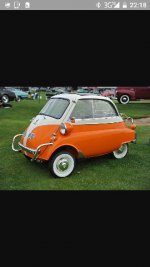So I was just sitting in my car yesterday, on the side of the road, enjoying it. As we all do right.
A group of elderly German folk walked up and of course started a conversation about how they used to drive these many years ago, and how you can park them anywhere etc etc
They then mentioned the Isetta, a car smaller and with funnier doors than the 500 D.
After looking it up, I think I’ve only ever seen one of these on the old series of Heartbeat about 20 years ago.
Wondering where these strange little cars fit in the hearts of 500 folk? They don’t seem to have had quite as glorious a history but they would certainly have a place on my ‘one day’ list of classic cars to own and love!
A group of elderly German folk walked up and of course started a conversation about how they used to drive these many years ago, and how you can park them anywhere etc etc
They then mentioned the Isetta, a car smaller and with funnier doors than the 500 D.
After looking it up, I think I’ve only ever seen one of these on the old series of Heartbeat about 20 years ago.
Wondering where these strange little cars fit in the hearts of 500 folk? They don’t seem to have had quite as glorious a history but they would certainly have a place on my ‘one day’ list of classic cars to own and love!





